Scarlet Badis (Dario dario) is a captivating freshwater fish hailed from the clear streams of India.
With a maximum size of just 2.5cm, it’s one of the smallest aquarium fishes, yet it boasts vibrant hues of red and blue that make it a visual delight.
While many aquarists prize them for their aesthetic appeal, a unique feature of the Scarlet Badis is its selective feeding behaviour.
Unlike many of its contemporaries, it often shuns processed foods in favour of live, minute prey like daphnia or micro-worms.
Their preference for live food, combined with their radiant appearance, makes them both a challenge and a treasure for seasoned fish enthusiasts.
Table of Contents
Scarlet Badis Facts & Overview
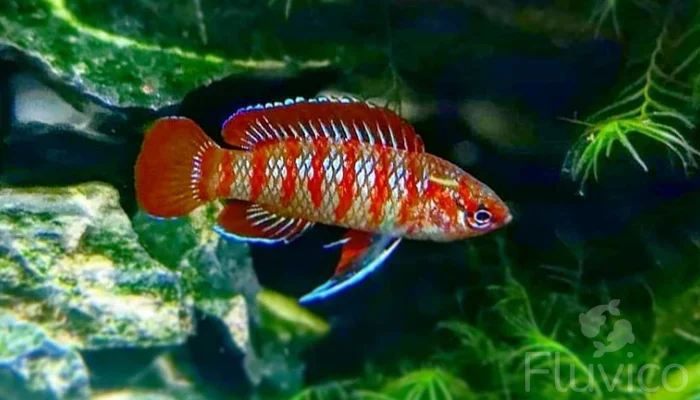
| Scarlet Badis Fact: | Details: |
| Scientific Name: | Dario dario |
| Common Names: | Scarlet Badis, Badis Badis, Baddi, Scarlet Gem |
| Care Level: | Moderate |
| Native Region: | Freshwater streams of India |
| Lifespan: | Up to 3-4 years in optimal conditions |
| Size: | Up to 2-2.5 centimetres |
| Family: | Badidae |
| Diet: | Omnivore (predominantly carnivorous) |
| Minimum Tank Size: | 30 litres for a single fish or pair |
| Compatibility: | Small, non-aggressive species and non-predatory invertebrates. |
History and First Sighting
The Scarlet Badis (Dario dario) was first identified in the clear waters of India. Initially recorded in the early 20th century, its unique vibrant hues immediately captivated ichthyologists. Nestled within India’s freshwater streams and rivers, these diminutive fish have since become a favourite in the aquarium trade.
Their discovery offered enthusiasts a glimpse into India’s rich aquatic biodiversity, underlining the importance of conservation efforts for such remarkable species.
Classification and Distribution
The Scarlet Badis, scientifically termed as Dario dario, belongs to the Cyprinidae family, which is an extensive group including many freshwater species. This classification underscores its relation to some common carp and minnow species.
As for its distribution, the Scarlet Badis is predominantly found in India, particularly in the regions of West Bengal and Assam. These fish favour slow-moving or still waters of streams, rivers, and ponds. The specific locales they inhabit emphasise India’s role as a hotspot for diverse and unique aquatic life.
Scarlet Badis Appearance
Size and lifespan
The Scarlet Badis is a testament to the adage that good things come in small packages. Measuring in at a diminutive 2.5cm at full maturity, this fish is one of the tiniest additions one can have in an aquarium. Despite their small stature, they command attention with their vivid colouration.
In terms of lifespan, with optimal care and a well-maintained habitat, a Scarlet Badis can thrive for up to 4 to 5 years. This longevity, combined with their compact size, makes them a sought-after choice for aquarists who cherish both aesthetics and the natural life cycle of their aquatic pets.
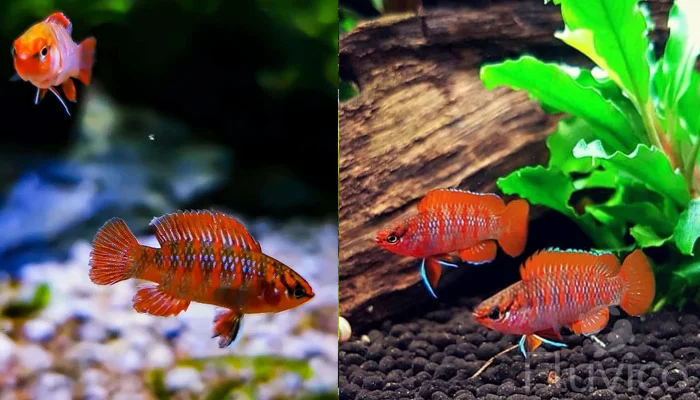
Common Colour Varieties
The Scarlet Badis, true to its name, primarily sports a radiant scarlet hue that captivates observers. This bold red is interspersed with striking blue patterns, particularly evident in males, which makes them stand out even in densely planted tanks.
While the vibrant red-blue combination is the most common and recognisable, there are subtle variations, especially in the intensity of the red, depending on factors like diet, health, and breeding conditions. Females tend to have a more muted colouration, often leaning towards a pale pink or brownish hue.
This natural variation in shades adds to the intrigue and allure of keeping these small wonders in an aquarium.
Sexual Dimorphism
In the realm of the Scarlet Badis, distinguishing between males and females is relatively straightforward due to their pronounced sexual dimorphism. Males are the true showstoppers, boasting vibrant red and blue patterns that shimmer under the right lighting.
Their colour intensity often amplifies during breeding seasons or territorial displays. In contrast, females are more subdued in appearance. They lean towards paler hues, typically manifesting in light pink or even brownish tones, and lack the pronounced blue patterns seen in males.
Additionally, females are slightly smaller and possess a rounder body shape. Recognising these distinctions is crucial, especially for those keen on breeding or understanding their behaviours.
Behaviour & Temperament
The Scarlet Badis is a true gem in terms of temperament. Predominantly peaceful, these fish are, however, territorial, especially males defending their chosen spots. While they might display bouts of chasing, it’s rarely aggressive or harmful. They’re often observed lurking amongst plants, foraging for tiny prey.
Being shy by nature, they appreciate densely planted areas which offer refuge. Despite their retiring nature, their vibrant colours and subtle behaviours provide endless fascination, making them a delightful presence in any peaceful community aquarium.
Scarlet Badis Care
What Size Aquarium Do They Need?
For the Scarlet Badis, a smaller footprint doesn’t mean compromising on their habitat. These fish, despite measuring a mere 2.5cm at adulthood, require ample space to display their natural behaviours. A tank of at least 30 litres is recommended for a pair or small group.
Larger tanks allow them to establish territories and reduce stress, promoting better health and colouration.
Moreover, with their preference for dense vegetation and hiding spots, having a spacious aquarium ensures they have ample room to explore and retreat when needed. In essence, while they may be one of the tiniest aquarium inhabitants, their space needs shouldn’t be underestimated.

Maintenance and Tank Setup
For the Scarlet Badis, creating a conducive environment is paramount for their well-being.
- Vegetation: Dense planting is preferable, mimicking their natural habitat and providing hiding spots.
- Substrate: Fine sand or small gravel suits their preference for bottom foraging.
- Water Flow: A gentle flow replicates the calm streams they’re accustomed to.
- Décor: Incorporate driftwood and leaf litter to offer additional shelter and mimic their native environment.
- Water Quality: Regular water changes and filtration are vital to keep the water parameters stable and toxins at bay.
Water Parameters, Lighting and Temperature
Maintaining an optimal environment for the Scarlet Badis requires careful attention to certain key aspects:
- Water Parameters: Ensure a pH level between 6.5 to 7.5, with a water hardness of 5-15 dGH. Maintaining these levels supports their overall health and well-being.
- Lighting: While Scarlet Badis are tolerant of various lighting conditions, moderate lighting enhances their brilliant colouration and supports plant growth.
- Temperature: A stable temperature range of 20°C to 25°C is ideal. Consistency is crucial, as sudden fluctuations can stress these petite fish.
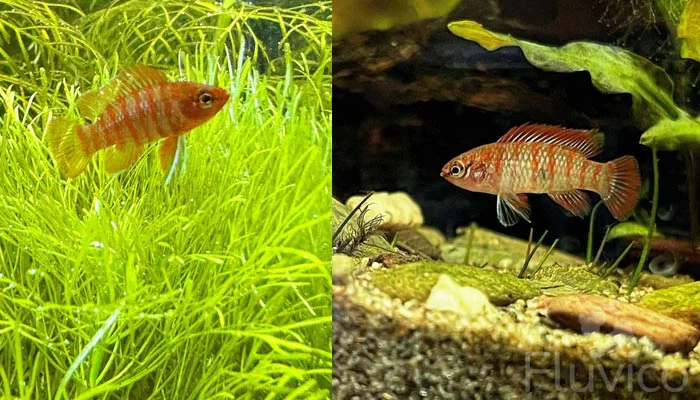
Compatible Plants and Décor:
Creating an ideal environment for the Scarlet Badis involves choosing compatible flora and decor to mimic their natural habitat:
Plants:
- Dwarf Hairgrass: Offers a lush green carpet and shelter.
- Monte Carlo: Provides a dense cover for the tank floor, perfect for these small fish to hover over.
- Java Fern: Hardy and provides excellent cover.
- Bucephalandra: A slow-growing plant with unique leaf patterns.
- Vallisneria: Tall and grass-like, it’s perfect for the tank’s backdrop.
- Water Wisteria: Its feathery leaves offer great shelter and aesthetics.
- Duckweed: Offers shade and a natural look.
- Frogbit: With long roots, it’s an excellent refuge for shy fish.
Decor:
- Driftwood: Provides essential hiding spots and enhances the tank’s aesthetic appeal.
- Rocks: Can be strategically placed to create territories or cave-like structures for refuge.
- Leaf Litter: Mimics their natural environment, aiding in their comfort and providing potential foraging grounds.
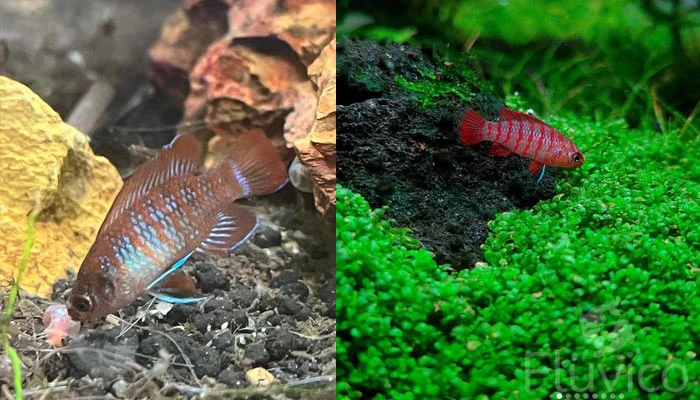
Scarlet Badis Food & Diet
The Scarlet Badis is known for its selective feeding behaviour, which can sometimes pose a challenge for aquarists. Catering to its diet ensures vibrancy, health, and longevity.
- Live Foods: This is the core of their diet. They have a particular fondness for:
- Daphnia: Small freshwater crustaceans.
- Micro-worms: Essential for providing necessary proteins.
- Brine Shrimp: Especially the newly hatched ones, which are tiny enough for them to consume.
- Frozen Foods: A good alternative to live foods. However, ensure they are thawed properly before feeding.
- Bloodworms: Although larger, younger Scarlet Badis can eat smaller pieces.
- Cyclops: Tiny crustaceans that can be an occasional treat.
- Processed Foods: While Scarlet Badis often shun traditional fish flakes or pellets, there are specialised nano pellets available that some might accept with time.
- Feeding Frequency: Ideally, feed them once or twice a day but in small quantities to avoid overfeeding and maintain water quality.
Changes in Behaviour
For any aquarist, understanding the typical behaviours of your fish and being vigilant about changes is vital for their well-being. For the Scarlet Badis, here are some behavioural shifts to be aware of:
- Lethargy: A sudden decrease in activity, where the fish stays at the bottom or hides constantly, may indicate illness or stress.
- Loss of Appetite: While Scarlet Badis can be picky eaters, a prolonged refusal to eat is a cause for concern.
- Erratic Swimming: Darting rapidly, swimming upside-down, or spinning can be signs of distress, disease, or water parameter imbalances.
- Surface Gasping: Continuously swimming near the surface and appearing to gasp for air might suggest oxygen deficiency or water quality issues.
- Scratching: If the fish rubs against objects, plants, or the substrate frequently, it might be experiencing irritation, often due to parasites.
- Aggression: A sudden increase in territorial disputes or aggression towards tankmates could be due to overcrowding, breeding behaviour, or stress.
- Colour Change: A noticeable fading or darkening of their vibrant hues, especially if rapid, might indicate stress, disease, or poor diet.
- Clamped Fins: Fins held close to the body, rather than being fanned out, often signals discomfort or illness.
- Isolation: While they are somewhat shy, if a Scarlet Badis isolates itself entirely from other tank inhabitants, it might be feeling unwell.
Always remember that a change in behaviour doesn’t necessarily mean illness. It could also be a response to environmental factors, such as water temperature, pH, or tank decorations. Regular observation, coupled with understanding their natural behaviour, will aid in differentiating between normal activities and potential signs of distress or disease. 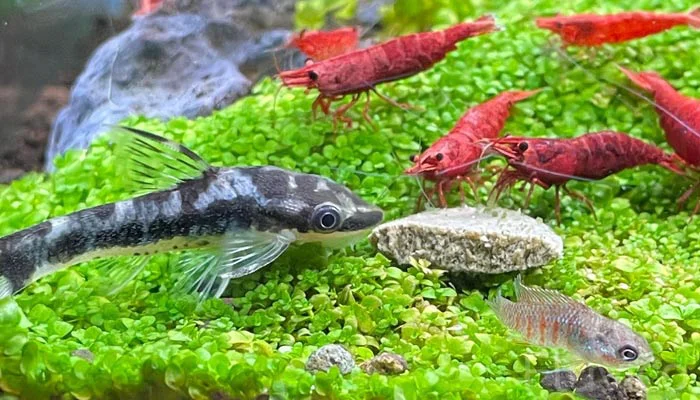
Scarlet Badis Tank Mates
Can You Keep Scarlet Badis Together?
Yes, you can keep Scarlet Badis together, but there are certain considerations to keep in mind:
- Territorial Males: Male Scarlet Badis are known for their territorial nature. If you’re planning to keep multiple males together, it’s essential to provide them with ample space and visual barriers, like plants or decorations, to establish their own territories. Without these provisions, there’s a likelihood of territorial disputes.
- Females: Females are less territorial than males and can coexist more peacefully. You can have a higher female-to-male ratio in a tank to reduce the likelihood of male aggression.
Tank Mates for Scarlet Badis:
Scarlet Badis, due to their peaceful and somewhat shy nature, can coexist with a variety of small, non-aggressive fish and other aquatic creatures. Here are some ideal tank mates:
- Small Tetras: Species like Neon Tetras or Ember Tetras are peaceful and won’t bother the Scarlet Badis.
- Rasboras: The likes of Chili Rasboras or Boraras brigittae are good choices, given their calm temperament.
- Pygmy Corydoras: These bottom dwellers are non-intrusive and will not compete with the Scarlet Badis for territory.
- Dwarf Loaches: Such as the Kuhli Loach.
- Shrimp: Small, non-aggressive varieties of shrimp, like Cherry Shrimp and Amano Shrimp, can coexist peacefully with Scarlet Badis. In fact, Scarlet Badis and shrimp can often be seen sharing the same space without issues.
Tank Mates to Avoid: Choosing the wrong tank mates can lead to stress, injury, or even the death of your Scarlet Badis. It’s best to avoid:
- Large, Aggressive Fish: Species like Cichlids, larger Barbs, or aggressive Catfish can harm or stress the small Scarlet Badis.
- Fin-Nippers: Fish like some types of Tetras (e.g., Serpae Tetras) can nip at the fins of Scarlet Badis, causing injury and stress.
- Predatory Fish: Fish that prey on smaller species, such as certain larger Bettas, should be avoided.
- Large or Aggressive Shrimp: Some larger shrimp species might be territorial or aggressive, potentially posing a threat to the Scarlet Badis.
- Sharks: Although they’re often sought after for their striking appearance, certain freshwater sharks like the Rainbow Shark and Black Shark are territorial and can display aggression, especially in confined spaces. Their size and territorial nature make them unsuitable tank mates for the Scarlet Badis.
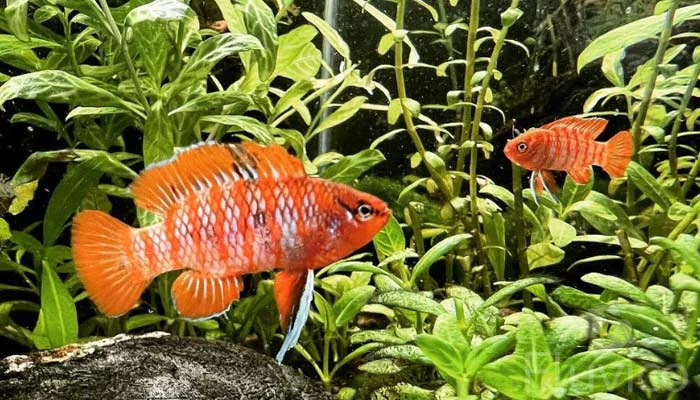
Breeding
Breeding Scarlet Badis requires attention to detail, especially when it comes to water parameters and diet. However, with dedication, you can successfully raise a new generation of these beautiful fish.Here’s a breakdown of the breeding habits and steps to encourage reproduction:
Total Time: Approximately 7-13 weeks
1: Tank Conditions:
Before you begin, it’s essential to establish the correct breeding environment. This includes:
* Soft water with a pH of around 6.5 to 7.
* A temperature ranging from 23°C to 26°C.
* Densely planted aquarium, offering hiding and spawning sites.
2: Sexual Dimorphism:
Males are more vibrantly coloured, typically brighter red with distinctive vertical blue stripes. Females are plainer with a more muted colour palette.
3: Diet:
Before breeding, both males and females should be fed a rich diet, including live or frozen foods such as daphnia, brine shrimp, and micro-worms to induce spawning.
4: Spawning Process:
Males will typically claim a territory, usually around a particular plant or hiding spot, and then display to attract females. Once a female is interested, she’ll approach the male’s territory. After a series of dances and displays, the female will deposit her eggs, and the male will fertilise them.
5: Egg Care:
Post-spawning, males may become protective of the territory where the eggs are. The eggs, usually laid on the undersides of leaves or in crevices, will hatch in about 2-3 days.
6: Fry Care:
Once hatched, the fry can be incredibly tiny and will require microscopic food sources. Infusoria (a mix of microscopic organisms) is the ideal initial food. As they grow, they can be shifted to micro-worms and newly hatched brine shrimp.
7: Separation:
It might be a good idea to have a separate breeding tank or to remove the adult Scarlet Badis after breeding. This ensures the safety of the fry as, in some cases, adult fish may predate on their young.
8: Growth:
With proper care, the fry will start showing colours in a few weeks and can be introduced to the main tank once they’re large enough not to be seen as prey by other inhabitants.
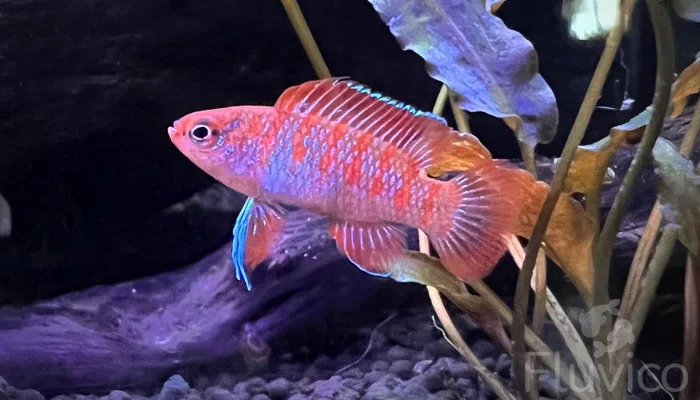
Should You Keep The Scarlet Badis?
The Scarlet Badis is a captivating gem in the freshwater aquarium world. Boasting vibrant hues and a calm disposition, they offer a visual treat and make an excellent choice for both novice and seasoned aquarists. While they require specific water parameters and a well-structured habitat, their unique behaviour and stunning appearance more than compensate for the care they demand.
If you’re seeking a petite, colourful fish that’s both engaging and peaceful, the Scarlet Badis is undoubtedly worth considering. However, ensure you provide them with an appropriate environment, the right tank mates, and a varied diet. If catered to properly, this dazzling species promises an enriching and delightful aquarium experience.
FAQ
Are Scarlet Badis aggressive?
Scarlet Badis are generally peaceful, but males can display territorial behaviour, especially during breeding. It’s important to provide enough hiding spots to reduce potential conflicts in a community tank.
How big do Scarlet Badis get?
Scarlet Badis typically reach a size of up to 2-2.5 centimetres when fully grown. They are among the smaller freshwater aquarium fish.
Can Scarlet Badis live with other fish?
Yes, Scarlet Badis can live with other small, non-aggressive fish. Ideal tank mates include small tetras, rasboras, and pygmy corydoras. It’s crucial to avoid larger or aggressive species that might bully or prey on them.
How many Scarlet Badis should be kept together?
It’s best to keep Scarlet Badis in pairs or small groups (about 6). However, ensure a larger tank and ample hiding spots if housing multiple males, as they can become territorial, especially during breeding times.
Why is my Scarlet Dadis dying?
Scarlet Badis might succumb due to unsuitable water conditions, stress from unsuitable tank mates, diseases, or lack of hiding places. Being picky eaters, they can starve if not provided with preferred foods, affecting their health.
More Reading

15 Types of Cryptocoryne: Which is Best For Your Aquarium Setup?

16 Awesome Low Light Aquarium Plants (Mosses, Ferns & Stem Plants)


18 Types of Aquarium Moss: Photos, Care, Propagation & Growth Guide


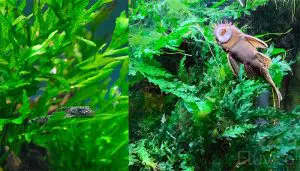

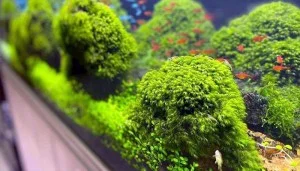
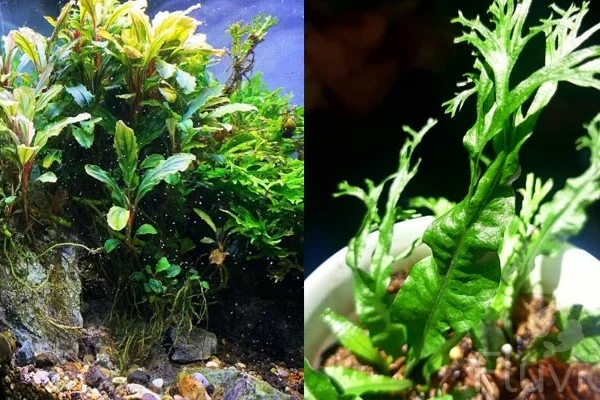

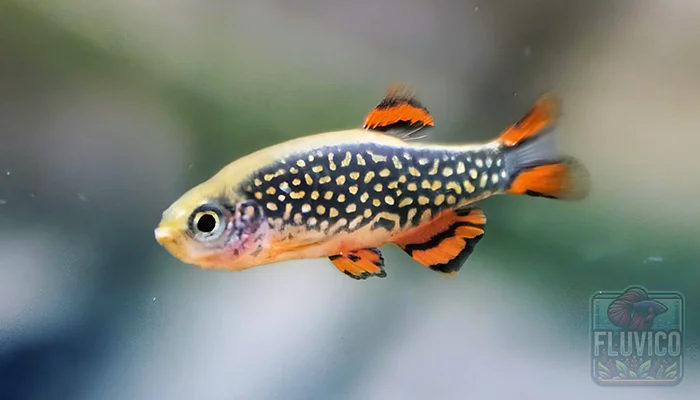
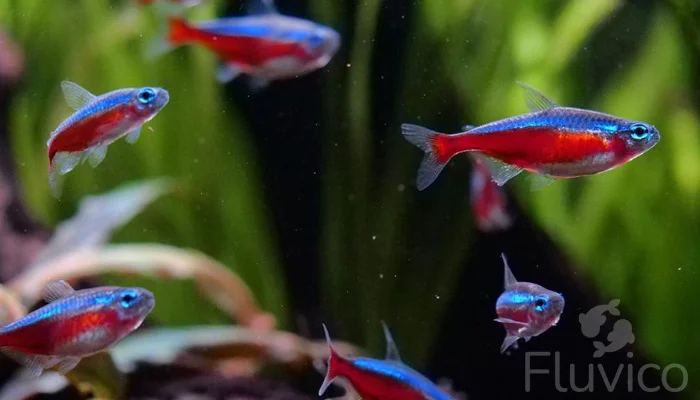
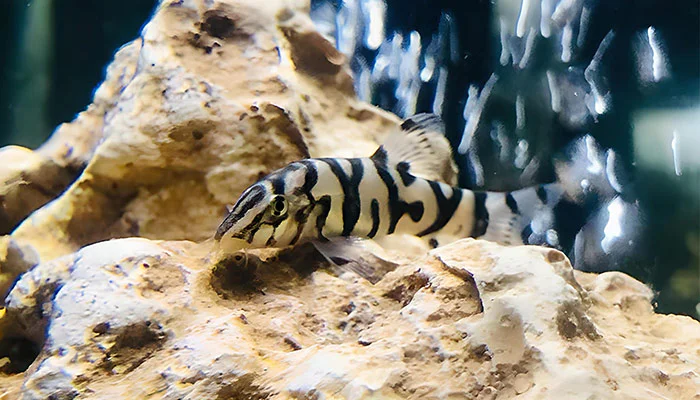
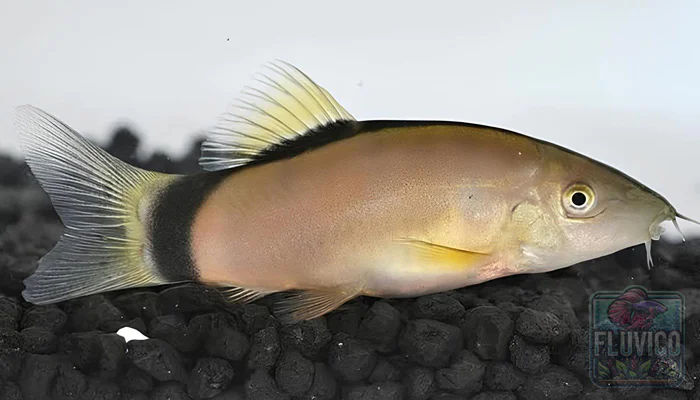
Hope you enjoyed our Scarlet Badis Care Guide!
If you have any questions? Ask away, we’re here to help!
All the best,
Daniel